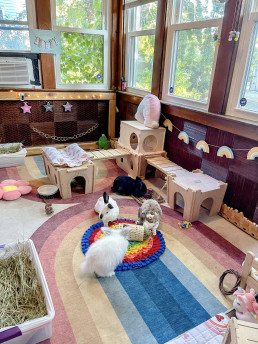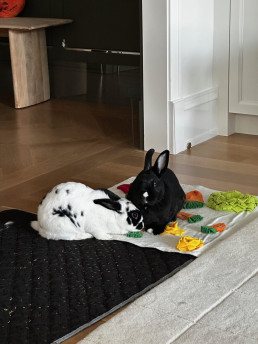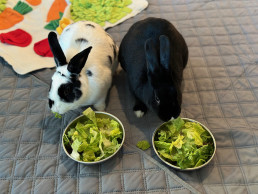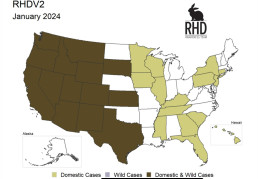Housing & Space Requirements
Rabbits are charming, intelligent companions who bring joy and warmth to our homes and should be given the same respect as cats and dogs. As responsible rabbit guardians, it is our duty to provide them with an environment that promotes both physical and mental well-being. We at HRS Chicago believe rabbits in North America are safest and happiest as indoor companions.
Understanding the Basics:
Indoor rabbit housing involves creating a space that mimics a rabbit’s natural habitat, allowing them to exhibit their natural behaviors. For folks who can’t let their rabbits free roam or live in a dedicated bunny room, creating a designated area with 2-3 exercise pens can be a good option. Rabbits should have the freedom to do zoomies and binkies at all times of the day, especially overnight when they are most active. Along with other rabbit welfare organizations, we are moving away from using single 4×4 pens for any length of time. This is not sufficient space for any rabbit. Keeping rabbits confined to a small pen can cause mental health problems like boredom and aggression. Being unable to run around freely leads to health issues such as arthritis, spondylosis, bladder sludge, and muscle wasting.
Space Requirements:
The Rabbit Welfare Association & Fund emphasizes the importance of providing sufficient space for rabbits to live comfortably. Their guidelines suggest a minimum of 10ft x 6ft of space for a pair of small to average sized rabbits. Larger breeds or more active rabbits will require even more space. This ensures that they have enough room to hop, run, stand on their hind legs, and stretch out – vital activities for their physical health and mental stimulation. Generally 30 inches is plenty of height to contain most rabbits in an indoor space, but occasionally you’ll need to invest in much taller pens for adventurous jumpers or climbers. Never ever lock a rabbit in a cage or a hutch for any length of time. Cages can be used as litter boxes if left open at all times but they can also cause territorial issues with bonded bunnies if they are enclosed. A hutch that’s left open 24/7 can be used as a hiding spot but keep in mind they can be very difficult to clean.
Creating a Stimulating Environment:
Rabbits are intelligent and curious creatures who still have most of their wild instincts and a well-designed indoor space can provide endless opportunities for mental stimulation. Incorporating tunnels, hides, dig boxes and a variety of toys can keep your rabbit engaged and prevent boredom. We suggest the use of cardboard boxes with entrances and exits as a way to mimic the burrows that rabbits would create in the wild. Rabbits also love to zoom through cat tunnels.
Additionally, providing platforms or ramps can add vertical space to the enclosure, allowing rabbits to explore and exercise their natural instinct to survey their surroundings. We cannot emphasize enough the importance of hiding places within the enclosure, as rabbits are prey animals and often feel safer when they have a secure space to retreat to.
Dig boxes can include shredded/crumpled paper or plastic balls. We do not recommend using sand in dig boxes as it can cause digestive upset if too much is ingested.
Baby stacking cups, plastic baby keys, wooden chews and puzzle toys are all great for providing mental stimulation and can prevent your rabbits from getting bored.
Location Matters:
Selecting an appropriate location for your rabbit’s indoor haven is crucial. We recommend choosing a quiet area away from excessive noise, any predatory pets, direct sunlight, and drafts. Rabbits are sensitive to their environment, and a peaceful location will help them feel secure and at ease.
Maintenance and Cleaning:
Maintaining a clean and hygienic living space is essential for the health of your rabbit. Regular spot cleaning and a thorough cleaning routine, including changing bedding and washing litter boxes, are vital aspects of rabbit care. Plain vinegar is a safe and effective cleaner for your rabbit’s space. If you’re not using litter box liners, it easily dissolves the calcium buildup in litter boxes as well.
Creating the perfect indoor housing for your rabbit involves thoughtful planning, incorporating elements to encourage their natural behaviors, and providing ample space for them to thrive. By following these basic guidelines, you can ensure that your rabbit not only survives but thrives in their indoor home. A happy and healthy rabbit is a joyous companion, and the effort you invest in their living space will be rewarded with years of happy and healthy bunnies!
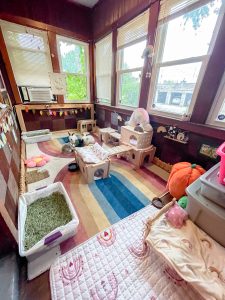
The Belden Buns
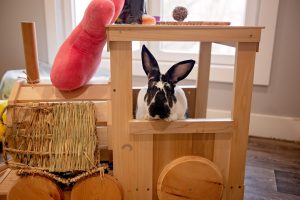
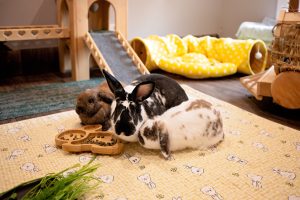
Agi Zeman’s trio

RWAF’s Space Recommendation
Adoption Policy
Adoption Process
- The adoption process starts with the prospective adopter submitting an adoption application.
- Once approved, applicants will be interviewed by phone or email by our Foster/Adoption Director.
- If the director(s) and the prospective adopter feel that adoption is right for everyone, the process passes to the foster person if applicable.
- Once an applicant is approved by all directors and foster people, we will schedule a home visit in the adopter’s home to approve housing. Please use our checklist to ensure your home is ready for your new rabbit(s)
- Once housing is approved, single rabbits will come to HRS Chicago for bonding. This takes about a week if the rabbits are compatible.
Our preferred adopter should have 1-2 years of previous house rabbit care experience or have done extensive research on proper care.
Our foster rabbits are in a network of foster homes throughout the Chicagoland area and all directors are volunteers with obligations outside of the rescue. Sometimes it can take a few weeks to coordinate everyone’s schedules for meet & greets. Thank you for your patience.
Adoption Policies
Primary Caregiver. When a rabbit is adopted from HRS Chicago, the primary caregiver must be a responsible adult 25 years of age or older. The rabbit should be treated as an integral part of the family, i.e., no group ownership (such as a classroom pet). We do NOT adopt rabbits as pets for children.
Indoor Housing. Adopters of HRS rabbits must understand that our rabbits are to live as household companions. This means they should not go on excursions outside or into public unless it’s absolutely necessary. No cages or hutches are to be used unless left open 24/7, a 10ftx6ft space should be available at all times.
Social Requirements. We recommend that all rabbits be kept in neutered pairs or groups. Companionship is a welfare requirement 🙂
Neutering and Vaccinating. All resident rabbits must be neutered and current on vaccinations.
Returns. If there are such problems with the adopted rabbit that the adopter needs to return the rabbit, we ask that you give HRS some advance notice. Once an animal is adopted from HRS, the space vacated is usually filled within a week. We will need time to either facilitate an adoption or make space at a foster home. Nevertheless, all rabbits adopted from HRS Chicago must be returned to HRS Chicago in the event the adopter is no longer able to care for them.
Exchanges. HRS does not exchange animals. Exceptions may be made when:
The fosterer and adopter are working together on making a match between an adoptee and a pre-residing rabbit and a different match would be less stressful for the animals.
Adoption fees. HRS Chicago adoption fees are donations that cannot be refunded. We are a federally recognized tax-exempt, nonprofit organization. Donations made to us are no more refundable than they are to any other public charity.
Adopting: A Better Choice Than a Pet Store Purchase
When it comes to bringing a rabbit companion into your life, adopting from a rescue or shelter is a much better option than buying one from a pet store or breeder. This choice not only saves lives but also offers numerous benefits for both you and your new furry friend.
- Saving Lives: Domestic rabbits in shelters and rescues are in need of loving homes. By adopting, you’re giving a second chance to a rabbit that might otherwise face uncertain or unfavorable circumstances. When you adopt from a rescue or shelter, you are also making room for them to save another life. Everyone wins, especially the bunnies.
- Responsible Breeding: There is no such thing as ethical or responsible breeding as long as rabbits are dying in shelters every day due to the overpopulation crisis caused by breeders.
- Health and Socialization: Rabbits from shelters and rescues receive proper health care, socialization, and behavior assessments. Rabbits from reputable rescues are spayed/neutered and vaccinated, which saves you money and reduces the risk of certain health issues.
- Behavior and Temperament: Adopted rabbits typically come with valuable information about their behavior and temperament. This helps you find a rabbit that matches your lifestyle and preferences.
- Rabbits in Need: By adopting, you’re contributing to the well-being of a rabbit in need, rather than supporting a commercial enterprise. It’s a compassionate choice that aligns with the principles of animal welfare and ethical pet guardianship.
- Support for Rescue Organizations: Your adoption fee goes toward the care and rehabilitation of other animals in need. Supporting rescue organizations helps them continue their important work.
- Community and Resources: Reputable shelters and rescues offer valuable resources, guidance, and support to adopters, helping ensure a successful transition for both you and your new rabbit companion.
Adopting your rabbit from a rescue or shelter is the responsible, ethical, and compassionate choice. It not only provides a loving home for a rabbit in need but also promotes responsible pet ownership and helps curb the demand for commercial breeding. If you’re considering adding a rabbit to your family, take the path of adoption to make a positive difference in the lives of these wonderful creatures.
Diet
Hay! – The GRASS Roots of the Diet
Hay is essential for gut and dental health. It should make up the majority of the rabbit’s diet. Rabbits should have access to fresh grass hay at all times. They should never run out. Refresh/top off at least once daily and expect for some to be wasted every day. Timothy, meadow, orchard, oat, brome, bluegrass and fescue are all great options. Alfalfa is a legume hay, not a grass hay. Providing several varieties helps to build a robust cecal flora which will make your rabbit more resilient to GI upset. Since rabbits are natural foragers, they prefer to eat their hay from the ground as opposed to hay racks and feeders. They also like to have hay piles in several different spots in their space. Consider stuffing small empty boxes with hay and leaving them around their space.
Pellets – Nutritional Supplement
Young Rabbits
Young rabbits require extra nutrients while they’re growing. Feed unlimited plain pellets to young rabbits. Begin to limit pellets to ½ cup – 1 cup daily around 9 months.
Adult Rabbits
1/8 – 1/2 cup of grass hay based pellets daily – plain pellets, no muesli type mixes with colorful treats or seeds. We recommend Oxbow Garden Select, Supreme Science Selective House or Grain Free, Sherwood, and Small Pet Select.
Senior Rabbits
Often as rabbits age, they can have trouble maintaining their weight. When this happens, they will require extra calories to keep them healthy. Consider increasing their normal amount of pellets or switching to a senior alfalfa based formula.
Long hair breeds will also require extra nutrition/pellets to keep them healthy and maintain a normal weight.
Some vets tell people not to feed pellets or to just use them as treats. HRS Chicago does not agree with this because 1) they don’t explain fully that each rabbit is individual and some need more nutrition than others 2) if you are only going to feed hay and greens it has to be about 3 different types of hay daily and 8 different types of greens daily (mixed to make a huge salad) to ensure complete nutrition and 3) their weight has to be monitored to make sure as they age they maintain muscle mass. HRS Chicago feels that the best way to ensure complete nutrition is to feed limited amounts of high quality, grass hay based pellet food.
Leafy Greens – Variety is the spice of life!
Rabbits don’t eat just one type of green veg in nature so we shouldn’t be offering just romaine for them every day. They greatly benefit from multiple types of leafy greens in the diet.
Volume – for adults, feed about 1 cup of greens per 5lbs of bunny.
Baby rabbits can start eating salad with mom when they start eating solids, around 3 weeks.
Below are some safe greens for your rabbit:
- Spring mix
- Arugula
- Basil
- Bok choy
- Fennel
- Escarole
- Endive
- Parsley
- Cilantro
- Dandelion greens
- Broccoli rapini
- Carrot tops
- Kale
- Endive
- Watercress
- Beet tops
- Dill
- Romaine
- Green/red leaf lettuce
NOTE: While dietary calcium does NOT cause stones or sludge like many people believe, we recommend limiting or omitting spinach from the diet as it is high in oxalates.
It’s best to avoid fruit and sugary vegetables(carrots, pumpkin, sweet potatoes, etc) entirely. Rabbits have specialized digestive tracts to allow fermentation to take place for fiber to be digested by bacteria and broken down into absorb-able forms of nutrients. So the fiber that rabbits eat does nothing in the small intestine. It travels to the cecum where fermentation takes place. The bi-products of that digestion are volatile fatty acids. When you feed an appropriate ratio of fiber to carbs, or non-digestible fiber to simple sugars, a certain ratio of volatile fatty acids is produced.
When you overfeed fruits in the rabbit a few things happen to the digestive tract.
- The simple sugars are absorbed in the small intestine and affect appetite/motility hormones, most specifically motilin, which when carbs are overfed is under-produced and GI motility is slowed down.
- The ratio of VFA’s produced by the cecum changes, because the population of bacteria changes to favor bacteria that prefer simple sugars. This lowers the pH of the cecum which causes
- The veriform appendix to overproduce bicarbonate to buffer the cecal contents. Rabbits that are fed too high of carbohydrates have grossly larger appendixes, are more prone to GI stasis, and may become overweight or have problems with excessive cecotropes.
Water from a clean crock/bowl is best for optimum hydration. Never use a bottle for rabbits as they can cause dehydration, stasis, kidney disease, chipped teeth, choking and neck pain.
NOTE: For rabbits that have chronic GI problems, it may be beneficial to completely remove pellets and/or salad from the diet. Some rabbits are sensitive to grains (found in most pellets) and some cannot tolerate any fresh greens. Please consult your veterinarian with any questions about transitioning to modified diets.
NEVER FEED
- Potatoes
- Avocado
- Chocolate
- Onion/Garlic
- Muesli
- Millet
- Nuts/seeds
- Bread
- Corn
- Dairy/yogurt drops
BRANDS TO AVOID
- Kaytee
- Purina
- Vitakraft
- Small World
- Rosewood Naturals
Click here to download our Rabbit Diet Guide.
© House Rabbit Society of Chicago
RHDV-2: Prevention & Treatment
Rabbit Hemorrhagic Disease Virus 2 (RHDV-2) is a highly contagious and deadly viral infection that affects domestic and wild rabbits. First identified in France in 2010, RHDV-2 has rapidly spread across the world, posing a significant threat to rabbit populations.
RHDV-2 Transmission and Symptoms
RHDV-2 is transmitted through direct contact with infected rabbits, as well as indirect transmission via contaminated food, water, insects or other contaminated objects. In some outbreak areas, it appears to spread along highways, so it’s believed to be moved around on car tires as well. You can also bring it into the home on your clothes and shoes. The virus can survive for extended periods at extreme temps outside the host, making it extremely hardy and easily transmissible. Once inside a rabbit’s body, RHDV-2 attacks the liver and causes internal bleeding, leading to a sudden and often fatal disease course. The typical symptoms of RHDV-2 often resemble classic stasis and include lethargy, anorexia(low or no appetite), fever, respiratory distress, and in some cases, neurological signs. Sometimes the only symptom is sudden, unexpected death. Affected rabbits may die within 12 to 36 hours of showing symptoms. It’s important to have your vet do a necropsy on any rabbit who dies unexpectedly so that there is an accurate representation of disease prevalence in our area.
Prevention of RHDV-2
ALL rabbits are at risk of infection, even if they never go outdoors. Preventing RHDV-2 is essential to safeguard rabbit populations, especially in regions where the virus is prevalent. Several key preventive measures can be implemented:
- Vaccination: Vaccination is the most effective means of preventing RHDV-2. Medgene’s safe and effective vaccine has been widely available since October 2021. Rabbit guardians should consult with their veterinarians to determine the most suitable vaccination schedule for their rabbits.
- Biosecurity: Maintaining strict biosecurity measures is crucial in preventing RHDV-2. Isolating new rabbits, keeping shoes outside, washing hands and changing clothing when handling new rabbits, regularly cleaning and disinfecting enclosures, and preventing contact with wild rabbits are key components of biosecurity.
- Quarantine: Quarantine newly acquired rabbits for a minimum of 21 days to ensure they are not carriers of the virus.
- Limiting Contact: Minimize contact between domestic and wild rabbits, as well as rabbits from different households.
- Monitoring: Keep a close eye on the health of your rabbits and be vigilant for any signs of illness. Early detection can be crucial in containing the spread of the virus.
Treatment of RHDV-2
Unfortunately, there is no specific treatment for RHDV-2. Once a rabbit shows symptoms, the disease typically progresses rapidly, and the mortality rate is extremely high, up to 90%. The focus should primarily be on prevention. Euthanasia is often recommended for affected rabbits to prevent further suffering and to limit the spread of the virus.
Management and Control
Managing RHDV-2 outbreaks is challenging, but there are strategies that can be employed to minimize its impact:
- Disinfection: Thoroughly disinfect cages, equipment, and any area where rabbits were housed or moved. Use appropriate disinfectants to kill the virus effectively. We recommend Rescue brand disinfectant or bleach.
- Containment: Isolate affected rabbits to prevent contact with healthy ones.
- Quarantine: Quarantine newly introduced rabbits and those returning from shows or other events to ensure they are not carriers of the virus.
- Public Awareness: Educate rabbit owners about the virus, its transmission, and the importance of vaccination and biosecurity measures.

